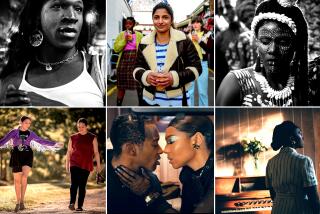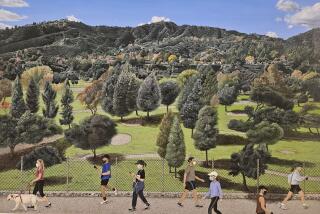Benefits Set for Film Project on Dance Pioneer
- Share via
Right now, what Lelia Goldoni wants most out of life is a guy she’s never met and $16,000. But don’t get the wrong idea: This former dancer, actress and now filmmaker needs both the man and the money to complete a documentary on the late Los Angeles dance pioneer Lester Horton.
To that end, Goldoni is presenting benefit performances by the New York-based company Footprints, tonight and Thursday at the Morgan-Wixson Theater in Santa Monica. Goldoni hopes the event will raise the money needed to support what she describes as “two months of very intense editing and post-production” on her documentary.
And the mystery man she’s anxious to meet? Strictly business: “I’ve been informed that someone called Warren Cheney was an art instructor at UCLA in 1937,” she says, “and that he did a film of (Horton’s American Indian-style) ‘Sacre du Printemps’ at Royce Hall. It’s not in the archives at UCLA so he obviously kept it. I want it and I want him, but I can’t find him. UCLA has records on him but not where he is.”
Titled “Genius on the Wrong Coast,” Goldoni’s documentary tells the story of a choreographer widely thought to be African-American because so many of the artists he developed weren’t white. Goldoni describes him as “a pink man from Indiana” who established not only a racially integrated company, but the nation’s first permanent theater reserved for dance in a building on Melrose that’s now an adult bookstore.
Horton’s choreography was not widely known outside L.A. until former company members began restaging it for East Coast ensembles. The dancers he trained include Alvin Ailey, Bella Lewitzky, Carmen de Lavallade, Joyce Trisler and Goldoni herself, who joined the Horton school at 12 and, soon after, the company. (The co-directors of the company performing at the benefit were trained at the Ailey school in the technique developed by Horton.)
“In 1987,” Goldoni recalls, “Alvin suggested we have a (Horton) family reunion. People came from all over the country. And I brought a video crew to record the event because God knows when we’d all get together again. As part of this event, I thought we should have people talk about their experiences at (Horton’s) Dance Theater and tell stories. Halfway through the evening, Alvin said to me, ‘You really should make a documentary. This is a good beginning.’ ”
The following year, Goldoni began work on the project in earnest, obtaining a Los Angeles Endowment grant and National Endowment for the Arts funding. Besides shooting more interviews, she began collecting historical footage on the Horton company--some of it from local television archives. Goldoni plans to issue it in two versions. “For general release, it will be an hour in length,” she says. “For colleges and universities, however, I plan to include all of the ballets intact--the whole pieces.”
Right up to his death in 1953, Horton worked extensively for Hollywood, choreographing sequences in such films as the 1943 remake of “Phantom of the Opera,” “Ali Baba and the 40 Thieves” (1944), “Salome, Where She Danced” (1945) and “Tarzan and the Leopard Woman” (1946). That facet of his career will also be represented in Goldoni’s documentary.
“Some of it is pretty funny,” she says, “but ‘Siren of Atlantis’ (1948) is actually real dance. The dancing itself isn’t embarrassing in any of the films, though frequently it’s performed by people who were not dancers: the stars. But it was part of being in Hollywood in those days and earning enough money to keep the theater going. There was a purpose to it.”
Goldoni recalls that Horton’s Dance Theater offered company members “a constant broadening and expanding of our education. At that time, the art world was totally integrated,” with painters and writers coming to dance performances and the dancers growing just as curious about other forms of expression--and the achievements of non-Western cultures as well.
“There was a constant flow and exchange of ideas and information,” Goldoni remembers, “and I find that happens less now. There’s a lot more isolation in the dance world, I believe.”
Horton’s death at age 47 initiated major changes in Goldoni’s life. “He was such an incredible powerhouse,” she says, “and no technique that I saw, and no choreography, ever grasped me in the way Horton’s work did. So I became very disinterested in dance altogether.”
Acting and New York beckoned, with Goldoni cast as the female lead in John Cassavetes’ first film, “Shadows,” in 1959. (“He had the same kind of charisma as Horton,” she remembers.) The film won awards at both the Cannes and Venice festivals with Goldoni nominated for a British Academy Award.
She worked in England during the next decade, returning to Hollywood in the mid-’70s. It wasn’t the same. “When I came back, I drove by Dance Theater and it said ‘Adult Theater,’ ” she says. “Well, I really didn’t know what that meant, so I went in and it really made me cry. It was sad to see that happen to a place with such an extraordinary history.”
More to Read
The biggest entertainment stories
Get our big stories about Hollywood, film, television, music, arts, culture and more right in your inbox as soon as they publish.
You may occasionally receive promotional content from the Los Angeles Times.










